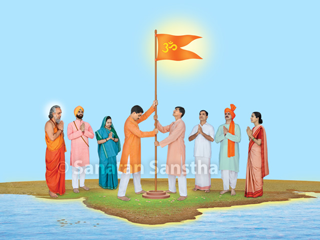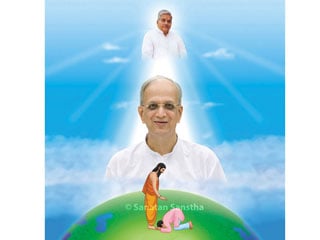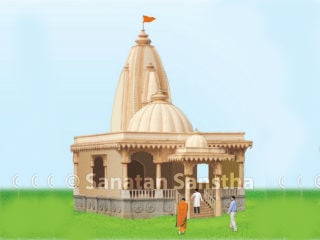Most of us visit the Devalay to have darshan of the Deity. In order to receive maximum Chaitanya (Divine consciousness) we must have the darshan in a spiritually correct manner. For this the Hindu Dharma has provided us with a set of guidelines based on shastras. Many of us have some common queries regarding the spiritually correct manner of darshan in a Devalay. In the following article some of these common queries have been answered.
1. Why is entering the garbha
-gruha (Sanctum sanctorum) prohibited?
Ordinary people cannot tolerate the Chaitanya emanating from the main energy flow of the Deity in the garbha-gruha and spreading all over; therefore, they are prohibited from entering the garbha-gruha.
The individual with a spiritual level of 50% has the ability to tolerate the Chaitanya emanating from the Deity and hence can enter the garbha-gruha. – A Scholar (Through the medium of Mrs. Anjali Gadgil, 15th February 2007, 9.19 p.m.)
2. What actions should be performed
after having darshan of the Deity’s Idol?
A. ‘There are two doors, one on each side of the garbhagar (Anteroom). After darshan of the Deity, come out through the door on the right side and have darshan of Agnidevta (Deity of Fire), that is, of the mandap (Hall) which has the yadnyakunda (Pit where yadnya [Ritual of sacrificial fires] is performed) (If it is there).
B. Then enter the garbhagar once again and come out of door on the left side and have darshan of the Idol of Deity Suryanarayan (If it is there).
C. Once again, enter the garbhagar, have darshan of the main Deity and come out of the main door of the garbhagar.
A. Science behind these actions: The sequence mentioned here is to have darshan of the main Deity first, followed by the darshan of Agnidevta and Suryanarayan and in the end darshan of the main Deity again. The symbolic meaning of these acts is that, first approach the nirgun (Non-materialised) Principle, followed by sagun (Materialised) activity performed on the strength of the nirgun Principle through the medium of the subordinate Deities (Agnidevta [who has Kshatratej (Radiance of a warrior class)] and Deity Suryanarayan [who has Brahmatej (Radiance of a Brahman, class which studies scriptures and imparts knowledge to the society)]) and then in the end dissolution in the original nirgun Principle. This is referred to as the ‘Doctrine of duality and non-duality’ or ‘one complete journey in the universe’. Through the entire journey of going from non-duality to duality and back to non-duality, God keeps working for the universe. – A Scholar (Through the medium of Mrs. Anjali Gadgil, 17th January 2005, 2.27 p.m.)
3. If the arrangement for pradakshina (Circumambulation) is not available in a Devalay,
will it be correct to perform radakshina around oneself ?
In case a Devalay does not have an arrangement for pradakshina, then there is no need to perform one around yourself. However, during an Arati (A ritual of waving a lit lamp in front of a Deity and Saints, accompanied by singing of hymns), the nada-shakti (Sound energy) is activated and performing pradakshina around yourself helps derive the benefit of specific vibrations from these sound waves. Hence, performing pradakshina around yourself only after the Arati is important.
4. What is the reason for not
performing pradakshina in places
like the samadhi (Mausoleum) of a
Saint, Devalay of Navagraha and Sun Devalay ?
Samadhi of a Saint, Devalay of Navagraha and Sun Devalay are the Shaktipeeths (Seats of Divine Energy), and hence as far as possible, avoid performing pradakshina around them. There exists a greater possibility of suffering distress when one performs pradakshina at places where only Shakti (Divine Energy) waves are accumulated. In the Devalay of superior Deities, since there is a harmonious cohesion of the sagun and the nirgun waves of Chaitanya, the possibility of experiencing distress by those having darshan is absolutely minimal. – A Scholar (Through the medium of Mrs. Anjali Gadgil, 18th January 2005, 11.51 a.m.)

 Frequently Asked Questions about ‘Hindu Rashtra’
Frequently Asked Questions about ‘Hindu Rashtra’ FAQs related to Gurukrupayoga
FAQs related to Gurukrupayoga Frequently Asked Questions on Guru (Spiritual guide) and Disciple
Frequently Asked Questions on Guru (Spiritual guide) and Disciple Importance of donating after having darshan (viewing) in a Devalay (Temple)
Importance of donating after having darshan (viewing) in a Devalay (Temple) Actions to be performed while leaving the Devalay (Temple) and their underlying science
Actions to be performed while leaving the Devalay (Temple) and their underlying science The seven layers in the arrangement of a Devalay (Temple)
The seven layers in the arrangement of a Devalay (Temple)